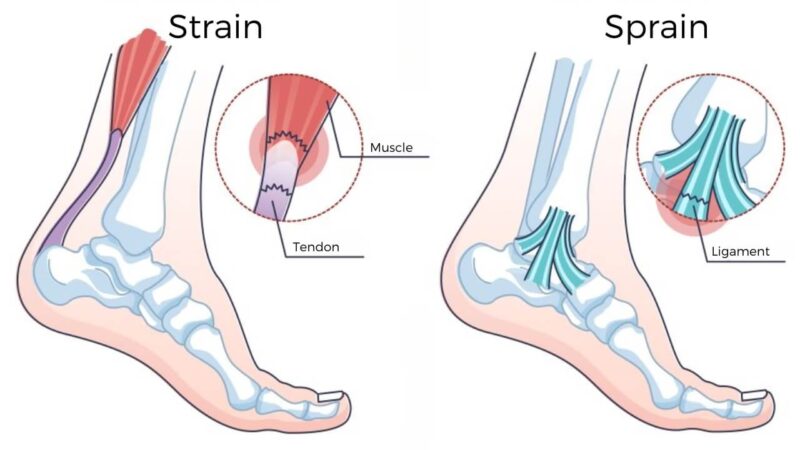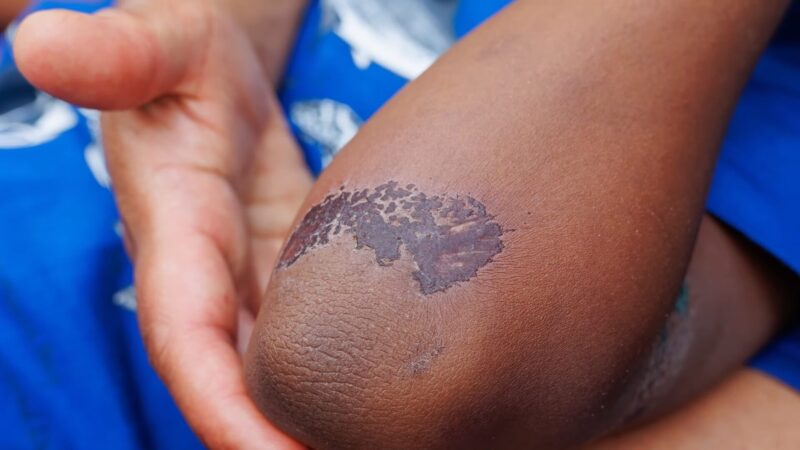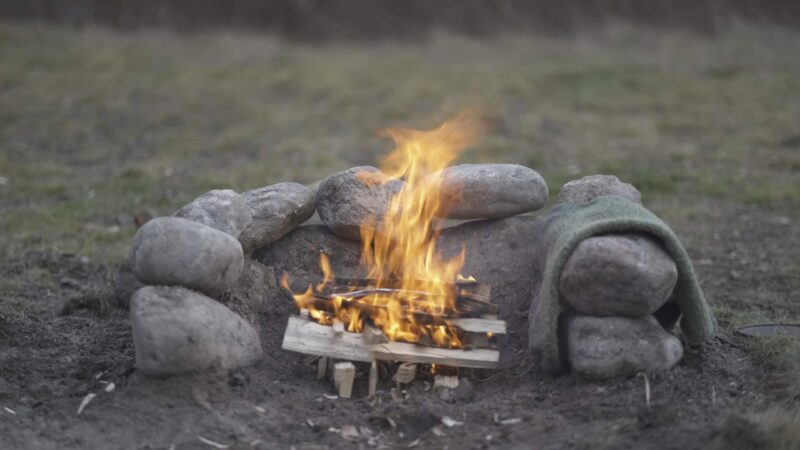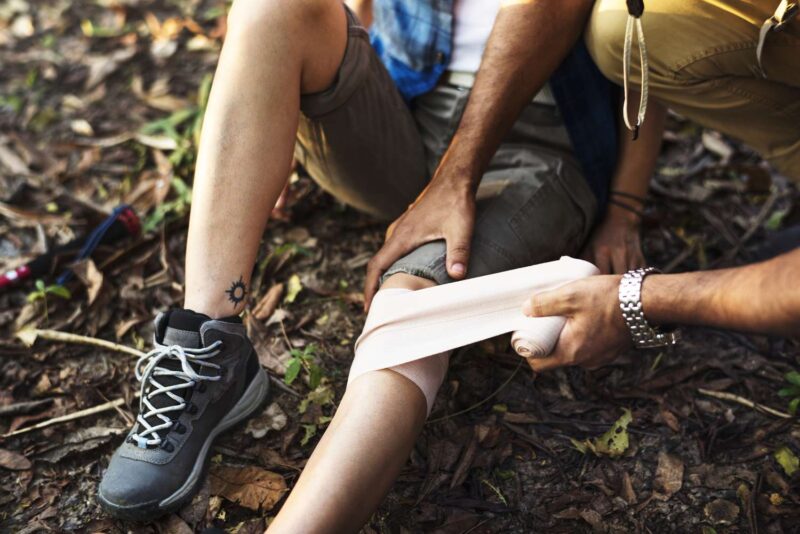Camping can be an exhilarating experience, offering a unique opportunity to connect with nature.
However, it also comes with its own set of risks.
Being aware of common injuries and knowing how to prevent and treat them can make your camping adventure both enjoyable and safe.
1. Sprains and Strains

Sprains and strains are among the most common injuries campers face, often resulting from navigating uneven terrain or slipping on wet surfaces.
Sprains involve overstretching or tearing ligaments, typically affecting the ankles, while strains involve injuries to muscles or tendons.
These injuries can be painful and may significantly hinder mobility, making it challenging to continue with camping activities.
To prevent sprains and strains, it is essential to wear appropriate footwear that provides good support and traction.
Hiking boots with ankle support are highly recommended. Additionally, performing warm-up exercises before engaging in strenuous activities helps prepare the muscles and reduce the risk of injury.
When hiking, it’s crucial to be mindful of your surroundings, taking care to navigate rocky or slippery areas carefully.
Using trekking poles can provide extra stability and reduce the strain on your lower body.
In the event of a sprain or strain, the RICE method. It stands for:
- Rest
- Ice
- Compression
- Elevation
Rest the injured area to prevent further damage.
Apply ice to reduce swelling and numb the pain. Use a compression bandage to provide support and minimize swelling.
Finally, elevate the injured limb above heart level to reduce swelling and encourage healing.
2. Cuts and Abrasions

Cuts and abrasions are common camping injuries caused by sharp objects, such as:
- Knives
- Branches
- Rocks
These injuries can range from minor scrapes to deep lacerations and can pose a risk of infection if not treated properly.
While minor cuts may only require simple first aid, more severe injuries might necessitate medical attention. Prevention is key to avoiding cuts and abrasions.
Wearing protective clothing, such as long sleeves, pants, and gloves, can shield your skin from sharp objects and rough surfaces.
When handling tools like knives or axes, always use caution and ensure you are using the proper technique to avoid accidental slips.
Keep your campsite clear of potential hazards like protruding branches or sharp rocks to minimize the risk of injury.
If you or someone in your camping group sustains a cut or abrasion, it’s important to clean the wound promptly to prevent infection.
Begin by washing your hands thoroughly, then clean the wound with clean water or an antiseptic solution to remove any dirt or debris.
Apply an antibiotic ointment to the area and cover it with a sterile bandage to protect it from further contamination.
For deeper cuts, applying pressure to stop bleeding and seeking medical attention is crucial.
3. Sunburn

Sunburn is a common issue for campers, especially during the summer months when the sun’s rays are strongest.
Prolonged exposure to the sun without proper protection can cause painful burns, skin damage, and increase the risk of skin cancer.
Symptoms of sunburn include:
- Redness
- Swelling
- Pain
- Blisters and peeling skin
Preventing sunburn is straightforward but requires diligence.
The most effective way to protect yourself is by applying a broad-spectrum sunscreen with an SPF of at least 30, covering all exposed skin.
Reapply sunscreen every two hours and after swimming or sweating.
Wearing hats, sunglasses, and protective clothing, such as long sleeves and pants, can further shield your skin from the sun’s harmful rays.
Whenever possible, seek shade, especially during peak sun hours between 10 a.m. and 4 p.m. If you do get sunburned, treating it promptly can help alleviate discomfort and prevent further damage.
The first step is to get out of the sun immediately.
Apply aloe vera or an after-sun lotion to soothe the skin and reduce inflammation. Over-the-counter pain relievers, such as ibuprofen, can help manage pain and reduce swelling.
Staying hydrated is crucial, as sunburn can cause dehydration.
Drink plenty of water and avoid alcoholic beverages, which can exacerbate dehydration.
For severe sunburns with blisters or extensive skin damage, seek medical attention.
Do not pop blisters, as this can lead to infection. Instead, cover them with a clean, loose bandage.
4. Insect Bites and Stings
Insect bites and stings are an inevitable part of camping, with mosquitoes, ticks, and bees being the most common culprits.
While most insect bites are harmless and cause only minor irritation, some can lead to more serious reactions, including allergic responses or diseases such as Lyme disease from ticks.
Preventing insect bites and stings involves several strategies.
Using insect repellent containing DEET or other effective ingredients can significantly reduce the risk of bites.
Wearing long sleeves, pants, and socks can provide a physical barrier against insects.
Avoiding scented products, such as perfumes or scented lotions, can also help, as these can attract insects.
Checking your campsite for nests or hives and avoiding those areas can prevent encounters with stinging insects.
If you are bitten or stung, prompt treatment can alleviate discomfort and prevent complications.
For bee stings, remove the stinger as quickly as possible by scraping it out with a flat object like a credit card. Clean the bite or sting area with soap and water to prevent infection.
Applying ice can reduce swelling and pain.
Over-the-counter anti-itch creams or antihistamines can help manage itching and allergic reactions.
If you or someone else shows signs of a severe allergic reaction, such as difficulty breathing, swelling of the face or throat, or a rapid heartbeat, seek emergency medical attention immediately.
Ticks should be removed carefully with tweezers, grasping the tick as close to the skin as possible and pulling straight out.
Clean the area thoroughly and monitor for signs of Lyme disease, such as a rash or flu-like symptoms.
5. Dehydration and Heat-Related Illnesses
Dehydration and heat-related illnesses, such as heat exhaustion and heat stroke, are significant risks during camping, particularly in hot weather.
These conditions occur when the body loses more fluids than it takes in, leading to an imbalance that can impair normal bodily functions.
Symptoms include:
- Dizziness
- Headache
- Muscle cramps
- Nausea
- Confusion
- Unconsciousness
Preventing dehydration and heat-related illnesses starts with staying hydrated.
Drink plenty of water throughout the day, even if you don’t feel thirsty.
Avoid caffeinated and alcoholic beverages, as they can contribute to dehydration.
Eating water-rich foods, such as fruits and vegetables, can also help maintain hydration levels.
Taking regular breaks in shaded or cool areas is crucial, especially during the hottest parts of the day.
Wearing lightweight, light-colored, and loose-fitting clothing can help keep your body cool. If dehydration or heat-related illness does occur, immediate action is required.
Move to a cool, shaded area and lie down.
Sip water or an electrolyte-replenishing drink slowly. Apply cool, damp cloths to the skin or take a cool shower if possible.
For heat exhaustion, elevate the legs to promote blood flow to the heart. If symptoms worsen or do not improve, seek medical attention immediately, as untreated heat stroke can be life-threatening.
6. Burns

Burns are a common risk in camping, often resulting from campfires, cooking accidents, or contact with hot equipment.
Burns can vary in severity from minor first-degree burns, which affect only the outer layer of skin, to more severe second or third-degree burns, which penetrate deeper tissues and require medical attention.
Preventing burns involves practicing good fire safety and handling hot objects with care.
Always keep a safe distance from campfires and never leave them unattended.
When setting up a campfire, ensure it is in a designated area away from flammable materials.
Use proper tools and techniques when cooking, such as long-handled utensils and heat-resistant gloves.
Teach children about the dangers of fire and establish clear boundaries around the campfire area.
If a burn does occur, immediate first aid is crucial to minimize damage and promote healing.
For minor burns, cool the affected area with running water for at least 10-15 minutes.
Do not use ice, as it can cause further tissue damage.
Cover the burn with a clean, non-stick cloth or bandage to protect it from infection.
Avoid applying butter, oils, or other home remedies that can trap heat and worsen the burn.
For more severe burns, especially those that blister or char the skin, seek medical attention immediately.
7. Allergic Reactions to Plants (e.g., Poison Ivy)
Contact with plants like poison ivy, oak, or sumac can cause allergic reactions in many campers.
These plants contain an oily resin called urushiol, which can trigger itching, redness, swelling, and blisters upon contact with the skin.
Knowing how to identify and avoid these plants is crucial to prevent allergic reactions.
Prevention starts with education. Learn to recognize poison ivy, oak, and sumac, which typically have three leaflets per stem.
Wearing protective clothing, such as long sleeves and pants, can reduce skin exposure.
When hiking, stay on established trails and avoid brushing against vegetation.
Washing your skin and clothing with soap and water after potential exposure can help remove urushiol and reduce the risk of a reaction.
If you do come into contact with these plants, prompt treatment is essential to alleviate symptoms. Wash the affected area with soap and water as soon as possible to remove the oily resin.
Applying over-the-counter treatments like calamine lotion or hydrocortisone cream can help relieve itching and inflammation.
For severe reactions, or if the rash covers a large area of your body, seek medical attention. Oral antihistamines can also help manage itching and allergic reactions.
The Bottom Line
Being prepared and aware of potential injuries is crucial for a safe camping experience. B
y taking the right precautions and knowing basic first aid, you can enjoy the great outdoors with confidence and peace of mind.

